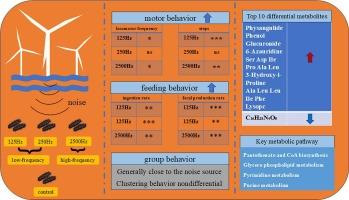海上风力发电机特征噪声对刺参行为和肌肉生理的影响
IF 4.9
3区 环境科学与生态学
Q1 ENVIRONMENTAL SCIENCES
引用次数: 0
摘要
海参通过其独特的行为和生理功能在维持生态平衡中起着至关重要的作用。然而,来自海上风力涡轮机的噪音破坏了海参的栖息地环境,可能会改变它们的行为和生理。然而,关于海上风力涡轮机的噪音如何影响海参的研究有限。在我们的研究中,我们通过四个实验组:对照组、125 Hz、250 Hz和2500 Hz,探索了特定风力涡轮机噪声频率对海参行为和肌肉代谢的影响。对海参摄食率、产粪率、步频和总步长进行统计分析表明,与对照组相比,低频噪声(125 Hz和250 Hz)显著提高了海参的运动和摄食活性。进一步的研究表明,低频噪声显著改变了海参肌肉中的代谢产物,改变了九种代谢物的水平,但不包括四氮环十二烷四乙酸。此外,四个关键的代谢途径显示出明显的变化:泛酸和辅酶a的生物合成、甘油磷脂代谢、嘧啶代谢和嘌呤代谢。这些发现表明,海参在行为和代谢方面适应人为噪声干扰。本文章由计算机程序翻译,如有差异,请以英文原文为准。

Characteristic noise of offshore wind turbine impacts the behavior and muscle physiology of sea cucumber Apostichopus japonicus
Sea cucumbers plays a crucial role in maintaining ecological balance through their unique behaviors and physiological functions. However, the noise from offshore wind turbines disrupts the habitat environment of the sea cucumber, potentially altering their behavior and physiology. Nevertheless, limited research exists on how noise from offshore wind turbines affects the sea cucumbers. In our study, we explored the effects of specific wind turbine noise frequencies on the behavior and muscle metabolism of sea cucumbers through four experimental groups: control, 125 Hz, 250 Hz, and 2500 Hz. Statistical analysis of the sea cucumber's ingestion rate, fecal production rate, step frequency and total step length showed that low-frequency noise (125 Hz and 250 Hz) significantly enhanced their locomotion and feeding activity compared to the control group. Further examination demonstrated that low-frequency noise significantly changed the metabolic products in sea cucumber's muscles, altering levels of nine metabolites, excluding tetraazecyclododecane tetraacetic acid. Furthermore, four key metabolic pathways showed marked alterations: pantothenate and CoA biosynthesis, glycerophospholipid metabolism, pyrimidine metabolism, and purine metabolism. These findings demonstrate that sea cucumbers adapt behaviorally and metabolically to anthropogenic noise disturbances.
求助全文
通过发布文献求助,成功后即可免费获取论文全文。
去求助
来源期刊

Marine pollution bulletin
环境科学-海洋与淡水生物学
CiteScore
10.20
自引率
15.50%
发文量
1077
审稿时长
68 days
期刊介绍:
Marine Pollution Bulletin is concerned with the rational use of maritime and marine resources in estuaries, the seas and oceans, as well as with documenting marine pollution and introducing new forms of measurement and analysis. A wide range of topics are discussed as news, comment, reviews and research reports, not only on effluent disposal and pollution control, but also on the management, economic aspects and protection of the marine environment in general.
 求助内容:
求助内容: 应助结果提醒方式:
应助结果提醒方式:


